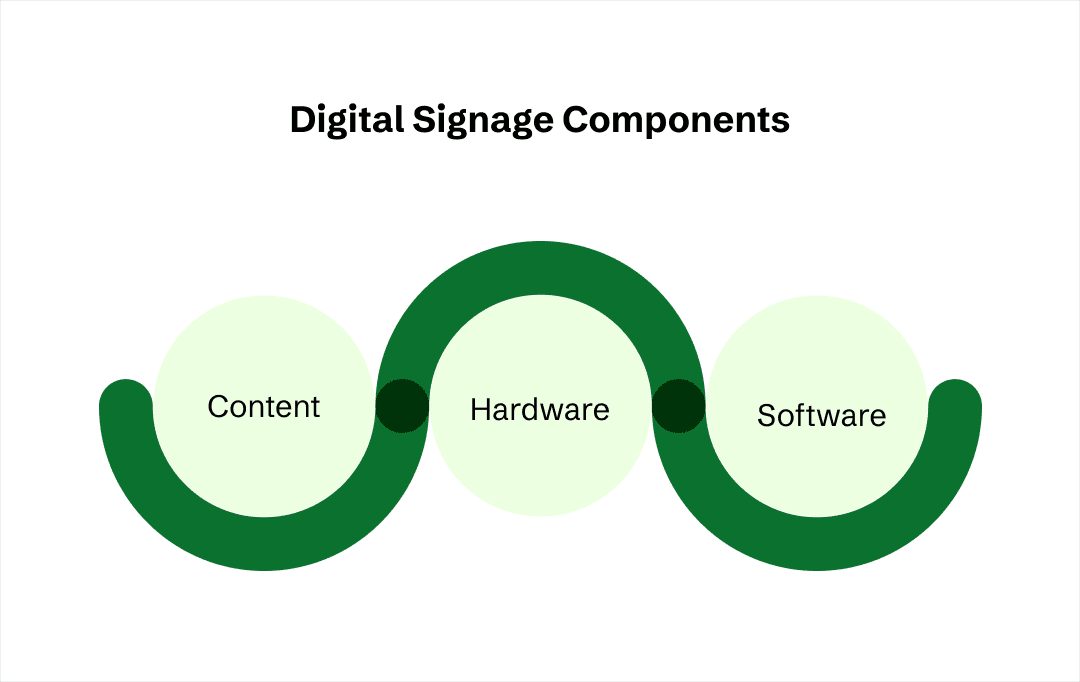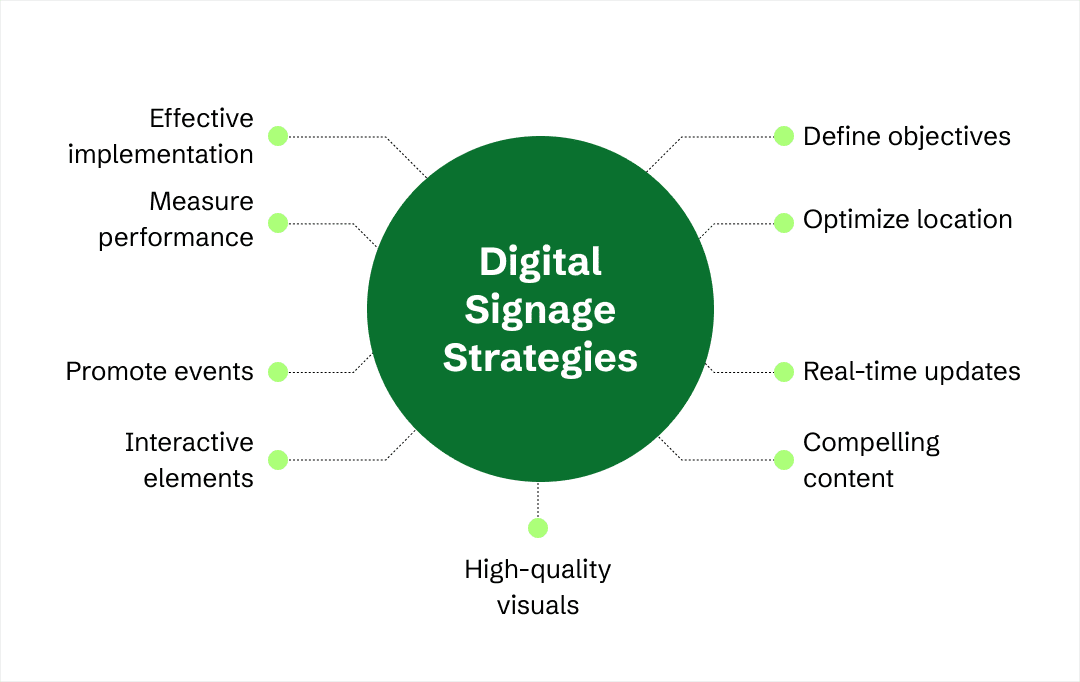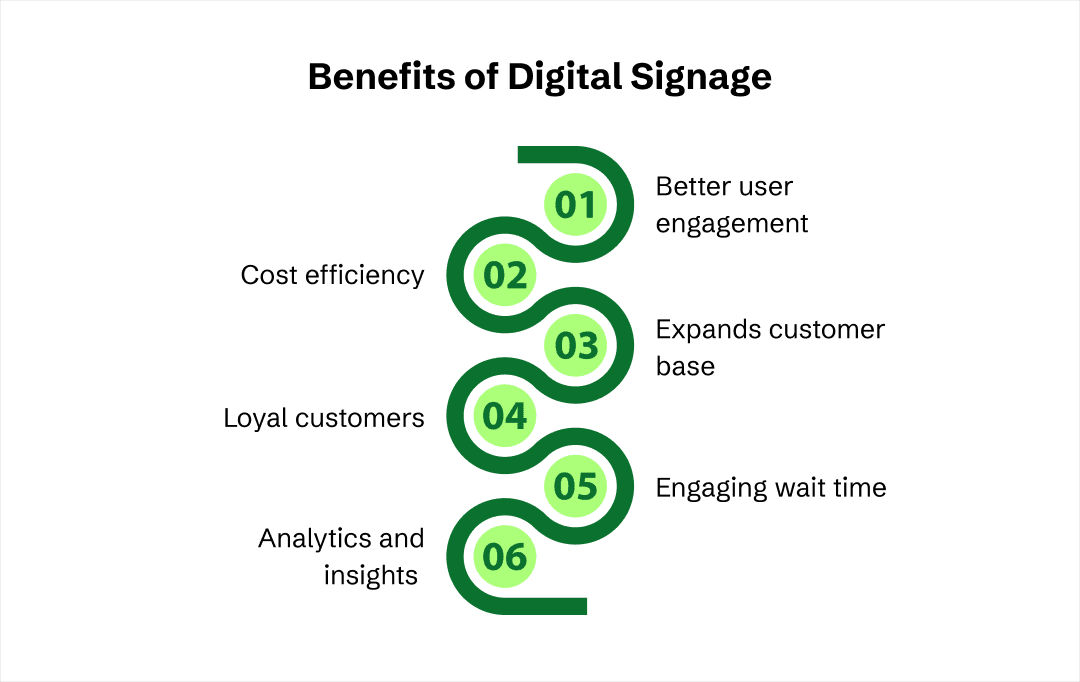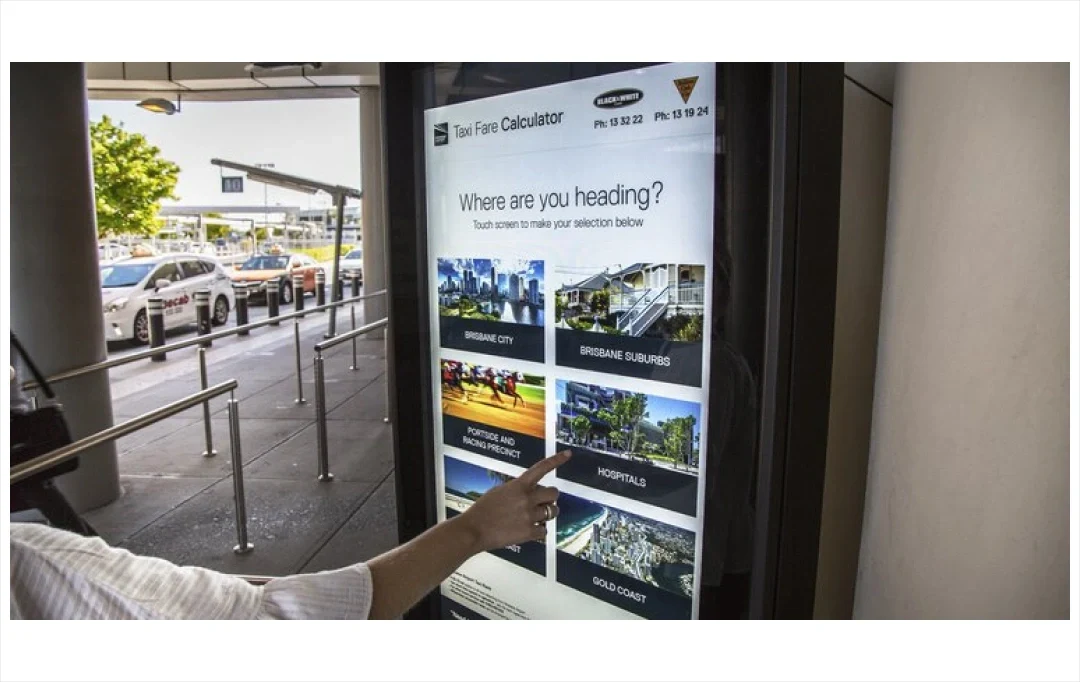
- Digital Signage: Bridging the Gap Between Online and Offline Marketing
-
Smart Digital Signage Tips for Small Businesses
- Define Clear Business Objectives
- Maximize the Visibility with Optimal Location Choices
- Incorporate Real-Time Updates
- Craft Compelling and Concise Content
- Optimize the Display with High Quality Visuals
- Leverage Interactive Elements in the Display
- Promote Events and Community Involvement
- Thoroughly Measure and Analyse Your Performance
- Implementing Your Chosen Solution Effectively
- Why Small Businesses Need Digital Signages: Top Advantages
- Additional Tips on Digital Signage Advertising Strategies
- Where to Deploy Digital Signage Software for Maximum Impact
- What is the Future of Digital Signage? 2025 and Beyond
- Wrapping Up

With the ever-increasing competition in the digital landscape, small businesses are struggling to capture a stronger consumer base and drive growth. This increases the necessity to leverage every possible tool to boost small business growth. Digital signage has emerged as a powerful and versatile solution that can help businesses achieve these goals.
By integrating dynamic displays and interactive content, small businesses can create unique customer experiences and communicate their messages more effectively. This blog will explore winning digital signage strategies and methods that small businesses can implement to fuel their growth.
From understanding the basics of a digital signage marketing strategy to leveraging advanced technologies and measuring success, we will provide practical insights and actionable tips to help you make the most of this powerful marketing tool. Let's dive into the world of digital signage and discover how it can transform your small business.
Digital Signage: Bridging the Gap Between Online and Offline Marketing
The global digital signage market grew by six billion in the year 2021 and is expected to grow more in the forthcoming years. As the popularity of digital content is on the rise, businesses are embracing interactive and large-scale digital signages. Digital signage or electronic signage uses advanced technologies to display webpages, videos, directions, and more on LCD monitors, LED walls, or others. These projections are used to display marketing messages to a large audience.
An effective digital signage strategy for small businesses can help them drive maximum sales by grabbing user’s attention. These signages can work in different public places, including museums, sporting arenas, markets, academic buildings, retail stores, and other areas.
Digital signage basically comprises three main components. Let’s understand them in detail.

Content for Digital Signage
Effective digital signage content strategies is the most important component, as they capture the reader’s interest. Businesses should have an inventory of audio, video, interesting images, graphics, and texts. All this is assembled in a way that communicates the brand’s story and mission.
Digital Signage Hardware
Hardware includes the physical or tangible components of digital signage. This can include screens, mounts, payment devices, cameras, and more.
Digital Signage Software
Digital signage software is a system that supports the working of the signage. From creation to management and analysis, it handles all the content displayed on the hardware.
Smart Digital Signage Tips for Small Businesses

Using promotional and marketing techniques for digital signage is a powerful tool for small businesses if harnessed effectively. From product promotion to improving the overall customer experience, digital signage marketing methods are extremely effective. Here are some smart digital signage advertising agencies for small businesses:
1. Define Clear Business Objectives
Before drafting digital signage marketing plans, businesses must state clear objectives. Laying down the objectives will allow businesses to have a clear understanding of what they are expecting from small business marketing strategies. Business objectives can include a variety of things, from improving sales brand awareness to maximizing overall sales.
Having solid objectives ensures that the strategies drafted are effective and impactful in the long run. Measurable objectives also enable businesses to measure their performance easily.
2. Maximize the Visibility with Optimal Location Choices
The placement of digital signage is extremely important for maximum customer reach. To maximize the effectiveness of the display, businesses must choose an accurate location for placing it. Waiting areas, entryways, checkout lines, and other places where customers spend most of their time are considered the best places for placing digital signage.
Strategic placement ensures that the businesses are able to send the message across to the maximum number of customers for the greatest impact. Additionally the height and angle of digital signage should also be decided strategically to ensure the best view for customers.
3. Incorporate Real-Time Updates
Digital signage makes it easier for businesses to update information and content on display. Real-time updates can include live weather updates, social media updates, news, or in-store promotions. With regular updates, businesses can keep the content fresh and relevant.
For businesses with real-time updates, inventory updates, or daily specials, updating the signage regularly can be extremely beneficial. Relevant and updated content improves business credibility and ensures that small businesses are responsive and dynamic.
4. Craft Compelling and Concise Content
The content displayed on the signage should be creative, sharp, and engaging. Small businesses can effectively utilize this platform to make important announcements or display their unique products through brief yet eye-catching content.
Additionally, businesses can aim to grab users’ attention by using bold colors with simple animations. Before drafting the content, businesses must keep in mind that they have a few seconds to capture the users’ eye.
5. Optimize the Display with High Quality Visuals
Once you are done mounting the displays, connecting the power sources, and configuring the software, the next step is to add quality visuals. Along with content, high-quality visuals can help businesses capture the users’ attention quickly. Using blurry or pixelated images can leave a negative impression on the customers’ minds.
Furthermore, the size of the video and images should be appropriate and formatted according to screen size. Investing in high-resolution images and videos reflects the professionalism of your brand.
6. Leverage Interactive Elements in the Display
If you are looking to optimize the effectiveness of your digital signage strategy, adding interactive elements is an excellent option. Engaging elements like QR codes, touchscreen, and motion sensors can be placed on the screen.
QR codes can be used to take users directly to your website; a touchscreen display can help customers browse through the product catalog. Adding indicative elements not only captures users’ attention but also encourages active performance.
7. Promote Events and Community Involvement
Digital signage is an excellent option for businesses to promote upcoming events, sales, and community involvement. These displays can be used to highlight sponsorships, local partnerships, or participation in community events that can foster goodwill.
Engaging with the community through your digital signage demonstrates that your business is an active and contributing member of the local area, which can strengthen customer loyalty and support.
8. Thoroughly Measure and Analyse Your Performance
To ensure the effectiveness of your digital signage, it is essential to measure and analyze its performance. Businesses can use analytics tools, sensors, user interaction data, sales data linking, and BI integration to track engagement metrics such as views, interactions, and conversions. Measuring and reading this data can provide valuable insights into what content resonates most with your audience and what areas need improvement.
For small businesses with limited resources, focusing on what works best can optimize marketing efforts and improve return on investment.
9. Implementing Your Chosen Solution Effectively
Once you’ve selected your digital signage solution, the next step is implementation. Follow a step-by-step guide to ensure proper installation and setup. This includes mounting the displays, connecting to power sources, and configuring the software. Regular maintenance and updates are necessary to keep your signage running smoothly.
Why Small Businesses Need Digital Signages: Top Advantages

Many businesses globally invest in digital signage as it is a high-ROI technology. Using effective digital signage marketing strategies enables small businesses to advertise their products among a larger audience at once. These assets are a great value addition for small businesses as these help them maximize their sales. But what else do they have to offer? Let’s find out.
1. Drives Higher User Engagement
Innovative digital signage marketing ideas help businesses improve their customer experience and subsequently increase engagement. Customers who are engaged with the products and services are more likely to make a purchase in the future. With electronic signage in place, businesses can represent their products through a digital catalog.
Digital signage can also display other important information like the price of the products, discounts, product availability, and much more. A signage should present all the information in an interactive manner to help consumers make an informed decision.
2. Promotes Cost Efficiency
Digital signage marketing cost is less as compared to other marketing techniques. Electronic signage helps businesses reduce the cost of printed marketing material. Additionally, this marketing method allows businesses to update the content quickly for their users. Updated content ensures that customers are updated with the latest information. It also empowers businesses to quickly adapt to the changing marketing trends without any additional cost.
3. Empowers Businesses to Expand Their Territory
Digital display technology enables businesses to promote their products and services around the world. With the latest trends and innovations, the content of digital signage can be updated within a few minutes. This technique ensures that the marketing of the products is not only limited to the local areas but is expanded globally. Advertising the business across different regions maximizes customer awareness and sales.
4. Builds a Loyal Customer Base
An interactive digital signage is more likely to leave a long-lasting impression on the customer’s mind, prompting them to make a purchase. Uniquely presented videos and images provoke customers’ purchasing intentions and subsequently help a business maximize profits. A perfect blend of vibrant graphics, engaging content, and a strong message is the best way for small businesses to promote their services.
5. Makes Wait Time Engaging
Most customers are frustrated while shopping in stores due to long wait times and queues. Small businesses can turn this wait time around to improve the customer experience. Digital signage can be placed anywhere inside or outside the store. With engaging content, businesses can entertain customers during long wait times.
Digital signage can help businesses improve the in-store shopping experience for all their customers. Creative and engaging signage can make the wait time feel shorter and improve customer satisfaction.
6. Provides Powerful Analytics and Insights to Businesses
Digital displays help businesses track user data to analyze their behavior and preferences. These analytics also allow businesses to improve their marketing strategies. The insights are also useful in optimizing and updating the content for users. Pairing digital signage with business intelligence software empowers businesses to develop a strong strategy.
Additional Tips on Digital Signage Advertising Strategies
- Some of the best digital signage marketing tips for small business owners are listed below. Follow these expert methods to ensure maximum return for your business.
- Optimize the digital signage for ambient lighting. Adjust the brightness and contrast settings to ensure that the display is clearly visible.
- Tailor the content as per different audience segments. Businesses can schedule specific messages at different times of the day or week.
- Display love social media feeds or user-generated content to create a sense of community.
- Ensure that the content for all digital signage aligns with the overall brand identity. The fonts, colors, and themes for all the display screens is properly aligned and is uniform.
- Sync digital signage with all the in-store promotions and POS systems. Highlight exclusive deals available in the store.
- Optimize the display with subtle motion graphics that are able to convey the message more dynamically.
- Experiment with different formats, including videos, slideshows, animations, and more. Regular testing can help businesses refine their strategies.
- Regularly inspect and maintain the digital signage to ensure that it remains in proper order.
- Encourage customers to provide feedback on your digital signage content. Tailor the content to meet the needs and requirements of the consumers.
Where to Deploy Digital Signage Software for Maximum Impact
Most industries implement digital signage promotional strategies to improve their overall ROI and sales. Some industries that commonly use digital signage include the following:
1. Airports and Transportation Hubs
Airports, train stations, and bus terminals are ideal places for digital signage deployment. Digital displays can provide travelers with real-time information on departures, arrivals, and delays, improving the overall travel experience. Wayfinding screens can help passengers navigate through complex terminals, while digital advertising screens can generate additional revenue by displaying targeted ads.

2. Educational Institutions
Schools, colleges, and universities can use digital signage to enhance communication across campuses. Digital displays can share important announcements, event details, class schedules, and emergency alerts.

3. Healthcare Facilities
Hospitals, clinics, and other healthcare facilities can benefit greatly from digital signage software. Digital screens in waiting areas can provide patients with important health information, educational content, and real-time updates on wait times.

4. Hotels and Hospitality Venues
In the hospitality industry, digital signage software can enhance guest experience by providing information and entertainment. Digital displays in hotel lobbies, elevators, and conference rooms can share information about hotel services, local attractions, and upcoming events. Interactive screens can offer guests the ability to check in, explore amenities, and even order room service.

5. Fitness Centers and Gyms
Fitness centers and gyms can utilize digital signage to keep members motivated and informed. Digital screens can display class schedules, fitness tips, and workout videos. Additionally, digital signage can be used to promote membership offers, highlight personal trainers, and share success stories. This not only enhances the member experience but also helps in building a strong community within the fitness center.

What is the Future of Digital Signage? 2025 and Beyond
The future of digital signage is set to witness significant advancements in the upcoming years. Here are some key predictions for an effective digital signage strategy for businesses.
1. Interactivity and Immersive Experiences
Future digital signage will focus on creating more interactive and immersive experiences. Touchscreen displays gesture recognition, and augmented reality (AR) will become more prevalent. This allows customers to interact with content in innovative ways. It is one of the most popular customer engagement trends that improves customer retention and creates memorable experiences.
2. Seamless Integration with IoT
The Internet of Things (IoT) will further enhance digital signage by enabling seamless connectivity between devices. Smart digital signage will be able to communicate with other IoT devices, such as beacons, sensors, and mobile apps, to provide contextual and location-based content. This integration will create a more cohesive and intelligent environment for delivering information.
3. Sustainable and Energy Efficient Solutions
As sustainability becomes a growing concern, digital signage will evolve to incorporate more energy-efficient and eco-friendly solutions. Advances in display technology, such as low-power LED screens and solar-powered signage, will reduce the environmental impact. Additionally, businesses will seek to use digital signage to promote sustainability initiatives and green practices.
4. Multi-Sensory Experience
Digital signage will move beyond visual content to create multi-sensory experiences. Integrating audio, scent, and tactile feedback will engage multiple senses and create a more immersive environment. For example, digital signage in retail stores might combine visual advertisements with background music and ambient scents to enhance the overall shopping experience.
5. Cloud-Based Content Management Systems
Cloud-based content management systems (CMS) will become the standard for digital signage, offering greater flexibility and scalability. These systems will allow businesses to manage and update their signage content remotely, ensuring consistency and efficiency across multiple locations. Cloud-based CMS will also facilitate collaboration and real-time content updates.
6. Contextual Advertising
The future of digital signage will see a shift towards more personalized and contextual advertising. Utilizing data from various sources, such as social media, loyalty programs, and mobile apps, digital signage will deliver highly relevant and targeted content to individual viewers. This personalized approach will increase the effectiveness of advertisements and enhance customer satisfaction.
Wrapping Up
In conclusion, adopting effective digital signage strategies can significantly enhance the success of small businesses. By leveraging dynamic and engaging content, businesses can capture customer attention, communicate their brand message, and promote products or services efficiently. Integrating digital signage with social media, using data-driven insights to tailor content, and ensuring regular updates and maintenance are key practices.
As technology evolves, small businesses that invest in innovative digital signage solutions will not only improve customer experience but also gain a competitive edge in the market, driving growth and profitability.
Frequently Asked Questions
-
How does digital signage improve business performance?
-
How to create a digital signage marketing strategy?
-
Is digital signage profitable?
-
What is digital signage used for?
-
What makes good digital signage?

Content Writer
Sakshi Kaushik is a wordsmith extraordinaire who transforms complex technical jargon into captivating, must-read articles. Armed with a Masters in Economics, Sakshi dissects intricate topics with the precision of a seasoned expert. Her insights have graced prestigious platforms like Hackernoon, Ecowiser, and Medium, captivating readers and tech aficionados alike. With a career spanning influential companies like Teleperformance, Finex, and SparxIT Solutions, Sakshi is well-versed in navigating both the keyboard and the boardroom.
In addition to her extensive experience, Sakshi holds HubSpot certifications in Digital Advertising and Content Marketing, and has earned further credentials from UpGrad, Coursera, and Great Learning. Dedicated to sharing her expertise with mobile app developers and tech enthusiasts, Sakshi's passion shines through her writing. When she's not crafting compelling content, she enjoys diving into thrilling novels and exploring diverse worlds.















